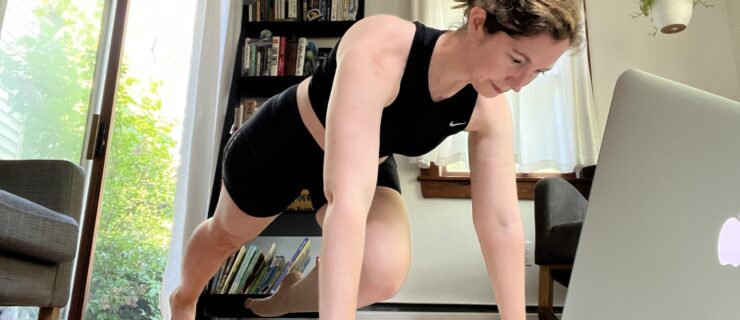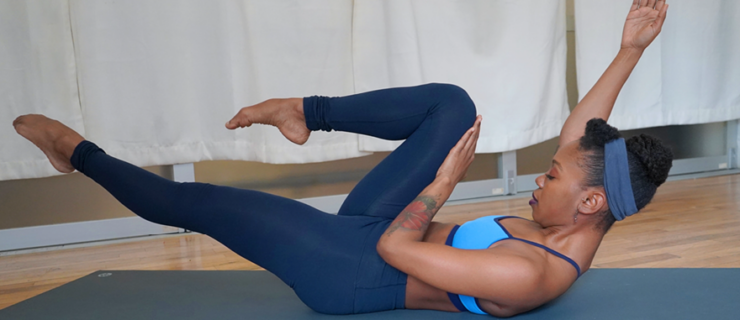Your Best Body: Beyond the Barre
Beyond The Barre
Strategic cross-training can transform your performance onstage.
Dancers work tirelessly to improve their technique, spending hours at the barre to become better performers onstage. However, the silver bullet to better performances may actually be at the gym. By now, dancers know they should cross-train. But most approach it all too haphazardly. What you do—or don’t do—in the gym can transform how you dance onstage. If you’re avoiding weight training or just aimlessly hopping on the elliptical, you’re missing out. Instead of working out just to burn extra calories, focusing on a strategic routine can actually help you become a stronger, more nuanced dancer.
Pick Up a Dumbbell
Too many dancers make the mistake of avoiding weight training, thinking it’s something dancers just shouldn’t do. Yet there are many practical benefits to lifting free weights. “Dancers need strength and power (the speed-related aspect of strength) to handle the high demands of today’s choreography,” says Nadia Sefcovic, physical therapist at New York City’s Westside Dance Physical Therapy. Working with free weights can improve both.
Strength and power will give you more control onstage to shade movement in the way you want. It will let you dance with greater attack, smoother transitions and more secure balances. “Gravity is the opponent that dancers are fighting every day—and gravity always wins,” says Houston Ballet’s certified athletic trainer Emery Hill. “You have to work as hard as you can to even out the battle.”
But what about bulky muscles? “Honestly, it takes several hours in the gym every week
lifting heavy weights to build big muscles,” says Sefcovic. Performing more repetitions with lighter weights will help you gain strength without bulking up. That’s because you’ll be working the slow-twitch muscle fibers, which are naturally smaller and don’t have the ability to grow as large as fast-twitch muscle fibers (which kick in when you’re lifting heavier weights).
“Weights are just a means of resistance,” says Erica Coffey, physical therapist for the dancers of Pittsburgh Ballet Theatre. “If you’re doing Pilates and using the reformer, the Cadillac or the chair, you’re getting resistance. There just isn’t a number attached to it, because we are talking about a spring as opposed to a weight.”
Truth be told, toning up can help you slim down. “Weight training helps to boost metabolism,” Sefcovic adds. When you increase muscle mass, your body burns more calories even when you’re just resting.
Turn In For Better Turnout
Make sure you leave your turnout in the studio. “It’s counterintuitive, but you have to work the opposite motion of what you are trying to gain in order to have some balance,” says Hill. “If you keep working the same motion, eventually it’s going to stop improving.” Focusing solely on cross-training exercises that allow you to work in turnout can be particularly detrimental—and even cause injury. Sefcovic often puts dancers on a bike or the elliptical to ensure they remain in parallel.
The whole point of cross-training is to work the muscles you don’t use when dancing. “Dancers can develop their strength, flexibility, power and endurance while giving some of those primary muscles they use day in and day out much needed recovery time,” says Coffey. “Muscle recovery is the equivalent of making sure you get enough sleep. Every part of your body needs some downtime.”
Smarter Cardio
Even though you go through all of the same movements, class does not fully prepare your body for the demands of performing a ballet. “Research shows that the level of aerobic workout that happens in a ballet class is pretty minimal,” says Coffey. Yet classical and contemporary choreography usually requires a great deal of stamina supported by a strong cardiovascular system. Build that endurance with 30 to 40 minutes of cardio a few times a week.
Cardio is also helpful for maintaining a lean physique. However, trainers disagree whether moderately paced cardio or interval training (where you push yourself to the limit for a short time then cool down, and repeat) is more effective at burning fat. “It’s a difference in philosophy,” explains Hill. “Some trainers believe that in order to tap into fat-burning systems you have to work at a lower intensity for a longer period of time. But others say that if you burn a thousand calories, a certain percentage of those are going to be fat calories, so why go slow when you’re just trying to burn total calories?”
For Hill, the best option is a combination of both: 20 minutes of interval training followed by 20 minutes at a lower intensity. Not only will this strategy burn a lot of total calories and get you closer to your fat-burning mode, it will also prepare you for the demands of ballet choreography, which can ask for bursts of energy as well as long stretches of simply moving—or holding still—onstage.
Kathleen McGuire writes about dance from Pittsburgh, PA.
Loosen Up
Feeling stiff? Make sure you’re getting enough “good fats.” A recent study at the University of Maryland Medical Center found that omega-3 fatty acids can decrease inflammation and joint stiffness. Heidi Skolnik, nutrition consultant for the School of American Ballet, recommends eating fish two to three times a week to get healthy amounts of omega-3 in your diet. Salmon, herring and mackerel are your best bets. But if you don’t like fish, don’t fret! Flaxseeds, soybeans, walnuts and seaweed are all smart alternatives.
D.I.Y. Energy Bars
Energy bars are a great snack to stash in your dance bag. Unfortunately, most of the brands at the supermarket are loaded with sugar, saturated fat and preservatives. Make your own version at home using your favorite ingredients in just a few easy steps. Try this recipe from Bobbie Marchand, a freelance dancer in New York City.
1 cup chopped nuts (almonds, pistachios, cashews, pecans or walnuts)
3/4 cup seeds (pumpkin, sunflower or flax)
1/2 cup dried fruit (raisins, cranberries, cherries, apricots or figs)
3/4 cup natural peanut butter or almond butter
1/4 cup honey
Mix nuts, seeds and fruit in a medium-sized bowl. Gently heat the peanut butter and honey until combined and smooth. Pour over nut, seed and fruit mixture and mix well. Press into a greased 8×8 pan, allow to cool, then cut into 12 to 16 bars. The bars keep for about two weeks in an air-tight container in the fridge.
Tip: Crunch Better
Does your neck get sore when you do crunches? The next time you hit the mat for ab work, press your tongue against the roof of your mouth. This simple trick forces you to keep the back of your neck straight, which prevents the muscles back there from straining.
5 Fat-Fighting Foods
Looking to fend off excess fat? Add these five healthy foods to your diet. Each has different benefits that help to keep your body lean.
1. Low-Fat Milk: Studies say three to four daily servings of high-calcium, low-fat dairy can nearly double the amount of fat you burn. Fat cells filled with calcium burn fat faster.
2. Grapefruit: Its vitamin C dilutes fat cells. Grapefruit also contains pectin, which prevents cells from absorbing fat.
3. Oats: This low–glycemic-index food is digested slowly, keeping blood sugar levels stable and cravings in check. A recent study found that people on a low-GI diet lost twice as much weight as those on a low-fat diet.
4. Eggs: One egg supplies 11 percent of your daily B12, which is said to break down fat cells.
5. Beans: Beans’ soluble fiber helps fend off blood sugar spikes that cause cravings. They are also packed with insoluble fiber, which keeps you fuller longer, and some experts say that it may also prevent the absorption of dietary fat.






